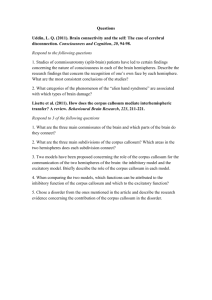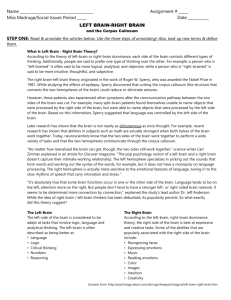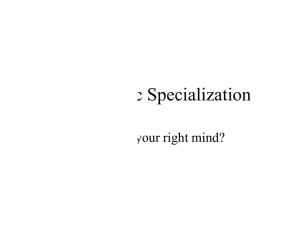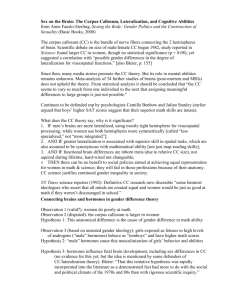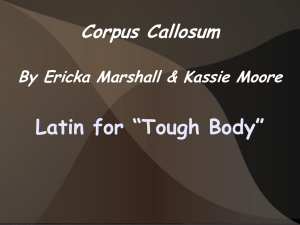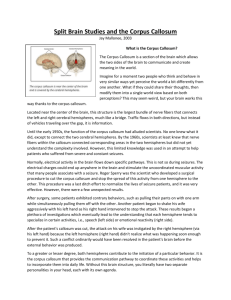Supplementary Data
advertisement
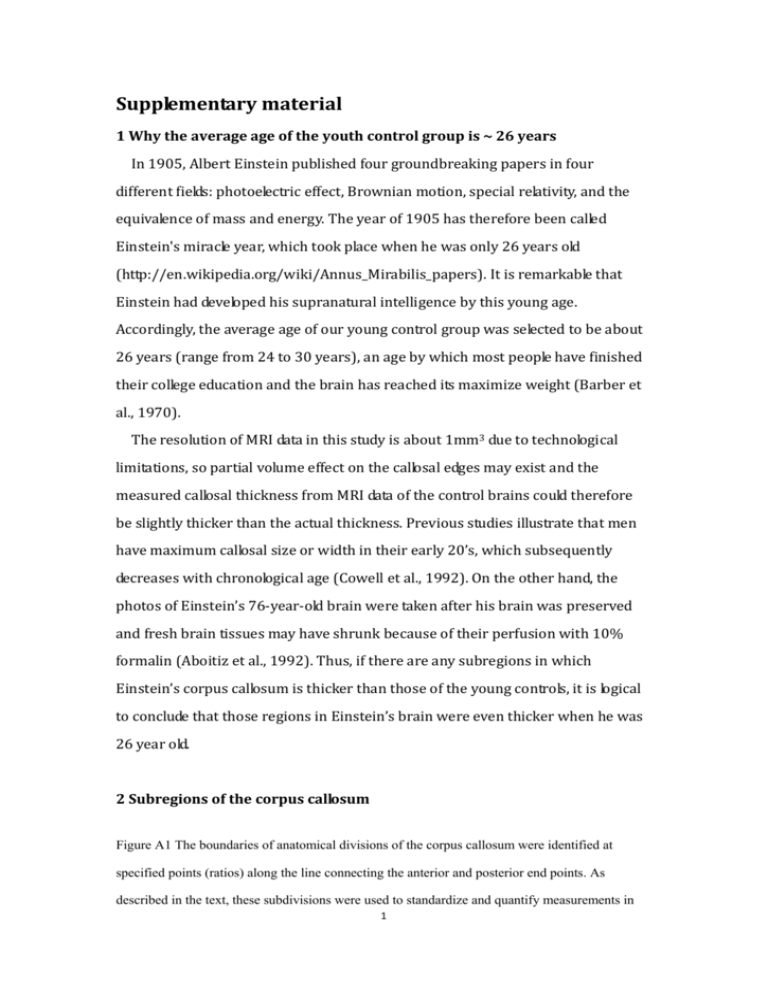
Supplementary material 1 Why the average age of the youth control group is ~ 26 years In 1905, Albert Einstein published four groundbreaking papers in four different fields: photoelectric effect, Brownian motion, special relativity, and the equivalence of mass and energy. The year of 1905 has therefore been called Einstein's miracle year, which took place when he was only 26 years old (http://en.wikipedia.org/wiki/Annus_Mirabilis_papers). It is remarkable that Einstein had developed his supranatural intelligence by this young age. Accordingly, the average age of our young control group was selected to be about 26 years (range from 24 to 30 years), an age by which most people have finished their college education and the brain has reached its maximize weight (Barber et al., 1970). The resolution of MRI data in this study is about 1mm3 due to technological limitations, so partial volume effect on the callosal edges may exist and the measured callosal thickness from MRI data of the control brains could therefore be slightly thicker than the actual thickness. Previous studies illustrate that men have maximum callosal size or width in their early 20’s, which subsequently decreases with chronological age (Cowell et al., 1992). On the other hand, the photos of Einstein’s 76-year-old brain were taken after his brain was preserved and fresh brain tissues may have shrunk because of their perfusion with 10% formalin (Aboitiz et al., 1992). Thus, if there are any subregions in which Einstein’s corpus callosum is thicker than those of the young controls, it is logical to conclude that those regions in Einstein’s brain were even thicker when he was 26 year old. 2 Subregions of the corpus callosum Figure A1 The boundaries of anatomical divisions of the corpus callosum were identified at specified points (ratios) along the line connecting the anterior and posterior end points. As described in the text, these subdivisions were used to standardize and quantify measurements in 1 thickness in various subregions of the corpus callosum. 3 Measurements of Einstein’s callosal dimensions Fig.1. clearly shows the left and right mid-sagittal callosal cross section in both hemispheres. Because there is no scale bar on either photograph they cannot be measured directly. However, the scale/callibration of these photographs can be determined using hemispheric lengths (17.2 cm left/ 16.4 cm right) reported in the literature (Anderson and Harvey, 1996). To reduce errors of Einstein’s corpus callosum measurement caused by rescaling and distortion, the corpus callosum on the left and right hemispheres were both measured. The maximum lengths of Einstein’s callosum on both hemispheres are consistent with the published measurements, so the two photographs have the same scale. The photograph of the left hemisphere was flipped horizontally in keeping with medical convention, and then rotated anticlockwise 3.2 degrees to align the maximum length of the corpus callosum along the horizontal, with the genu on the left and splenium on the right. The photograph of the right hemisphere was also rotated to align the maximum length of corpus callosum horizontally. There is a little breach under the callosal rostrum in both hemispheres (Fig. 1). The breach on the left hemisphere is ‘M’-shaped and on the right hemisphere is like a flipped ‘V’. If there was only one breach in Einstein’s corpus callosum, it would be the same shape on both hemispheres. Additionally, the entire corpus callosum shows "saw" marks that are probably from the scalpel that was (presumably) used to separate the two hemispheres, and one of these marks is seen on the breach of the left corpus callosum. In contrast, all controls’ corpus callosums were carefully reviewed and no breaches were found. Nor does this feature appear in previously published pictures of corpus callosum (Park et al., 2011; Wang et al., 2009) . Hence, it is very likely that the breaches under the callosal rostrum in both of Einstein’s hemispheres were introduced when the two hemispheres were separated in 1955. The breaches were therefore ignored when outlining the callosal contours. 2 To measure regional callosal thicknesses/widths in the midsagittal plane, the contours of both corpus callosums were outlined by one rater (M. W.) using ImageJ software (National Institutes of Health,http://rsb.info.nih.gov/ij/). The boundaries of the callosum on both hemispheres were identified by the pixels at the edge of callosal masks; top and bottom edges were defined according to anterior and posterior end points. The anterior end points were easy to identify at the callosal anterior tip, and the posterior end points were estimated repeatedly to assure that the maximum length of the callosal middle line was determined. The middle line of a 2D object was defined by the Symmetry-Curvature Duality Theorem (Leyton, 1987). An approximate middle line is determined by searching the points on the callosal mask. Briefly, the points on the middle line have two characteristics, the distance of one point to the top edge plus the distance of this point to the bottom edge has a minimum value and the difference between two distances also has a minimum value. The edges of the top, bottom and middle lines (running rostrocaudally through the center of the corpus callosum) were redigitized with a b-spline interpolation, resulting in 400 points per section. According to the characteristics of the middle line, for every point on the top edge a point exists on the middle line which is the shortest distance from it. The points on the bottom edge are also determined by their shortest distances from corresponding points on the middle line. Once the corresponding points were identified, the distances from the points on the top edge to their corresponding points on the bottom edge were calculated, and defined as the thickness of corpus callosum at their respective locations. The middle points of these segments determined a new line coursing rostrocaudally through the middle of the corpus callosum, which was more accurate than the old one, and the anteroposterior length of this curve could be calculated (length of corpus callosum). However the distance of any two adjacent points on this new line were not equidistant, so another b-spline interpolation was performed on this new middle line, top edge and bottom edge, resulting in a modified middle line with 400 equidistant points, top edge and bottom edge with 400 3 corresponding points but not equidistant. Each point on the middle line corresponded with a measurement of callosal thickness, and the value of thicknesses were coded in color and mapped onto the Einstein’s left callosal space in Fig. A2. The average corpus callosum thickness plot of Einstein is shown in Fig. 3 (red thick line). The average callosal thickness distribution of Einstein was coded in color and mapped onto the middle line of Einstein’s callosum on the left hemisphere (Fig. A2, 4 and 5, top row). The circularity of corpus callosum is defined as: 4πA/P2, where A is corpus callosum area and P is perimeter(Ardekani et al., 2013). 4 Measurements of control groups Image volumes were manually reoriented to a standard coordinate system of the ICBM-152 brain space using a six-parameter rigid-body transformation with SPM8 (Statistical Parametric Mapping, Wellcome Trust Centre for Neuroimaging, Britain), then the non-uniform intensity of images caused by magnetic field inhomogeneities was removed by N3 (Sled et al., 1998) and SPM8 . The voxel size of bias corrected image volumes were resampled to 0.2 × 0.2 mm2 in sagittal plane resolution, with a slice thickness of 0.4 mm. The callosal contour was delineated on a midsagittal section in which the aqueduct cerebri and the fourth ventricle were visible. The callosal measurements of the control brains were the same as Einstein’s brain. Each individual has a unique brain and corpus callosum, thus their callosal subdivisions must differ (Witelson, 1989). Each individual’s corpus callosum plot can be found in Fig. 3A and 3C. To compare the difference between Einstein’s callosal thickness and that of control brains, the callosal thickness distribution was subdivided into three sections, and the sections of the control groups were registered to corresponding sections of Einstein’s corpus callosum. Procedures are described as follows: the maximal callosal thicknesses in the genu, the 4 minimal thickness in the isthmus, and the corresponding numbers of landmark points in the callosal middle line from 1 to 400 were found in both Einstein’s corpus callosum and in each individual control’s corpus callosum. The callosal thickness distributions of Einstein and all individuals were partitioned into three sections and each section for the individuals was registered to the corresponding section of Einstein’s corpus callosum with a linear interpolation. The registered plots of controls are shown in Figs. 3B and 3D, the registered thickness maps are shown in the right column of Figs. 4 and 5. In order to measure the average brain volume and weight, the segment functions of SPM8 and ICBM-152 nonlinear symmetric templates version 2009 (Kim et al., 2011) were employed, and the grey matter (GM) and white matter (WM) were segmented from the MRI data, respectively. The brain volume was calculated by summing the volume of GM and WM, thus the brain weight was calculated with the brain volume multiplied by the average brain density (1.081g/cm3)(Barber et al., 1970). The callosal contours, middle lines and thickness maps of Einstein and two control groups are shown in Figs. A2 and A3. The corpus callosum circularities of controls were calculated as they were for Einstein’s corpus callosum. Figure A2 The corpus callosum thickness maps of Einstein and the elderly control group. The first two color background pictures are Einstein’s left (flipped to a right view) and right midsagittal surfaces. Each individual corpus callosum was segmented by 400 equidistant points along the corpus callosum middle line, and the corresponding thickness of the point on the corpus callosum middle line was coded in color and mapped onto the individual corpus callosum middle line. Einstein’s right corpus callosum middle line looks a little different in the splenium than the left one, which was probably caused by distortion during preservation. Figure A3 The corpus callosum thickness maps for the youth control group. References: Anderson B, Harvey T. Alterations in cortical thickness and neuronal density in the frontal cortex of Albert Einstein. Neurosci Lett 1996; 210: 161-4. 5 Ardekani B, Bachman A, Figarsky K, Sidtis J. Corpus callosum shape changes in early Alzheimer’s disease: an MRI study using the OASIS brain database. Brain Structure and Function 2013: 1-10. Barber TW, Brockway JA, Higgins LS. The density of tissues in and about the head. Acta Neurol Scand 1970; 46: 85-92. Kim SH, Fonov V, Piven J, Gilmore J, Vachet C, Gerig G, et al. SPATIAL INTENSITY PRIOR CORRECTION FOR TISSUE SEGMENTATION IN THE DEVELOPING HUMAN BRAIN. Proc IEEE Int Symp Biomed Imaging 2011: 2049-2052. Leyton M. Symmetry-curvature duality. Computer Vision, Graphics, and Image Processing 1987; 38: 327-341. Park JS, Yoon U, Kwak KC, Seo SW, Kim SI, Na DL, et al. The relationships between extent and microstructural properties of the midsagittal corpus callosum in human brain. Neuroimage 2011; 56: 174-84. Wang D, Shi L, Chu WC, Paus T, Cheng JC, Heng PA. A comparison of morphometric techniques for studying the shape of the corpus callosum in adolescent idiopathic scoliosis. Neuroimage 2009; 45: 738-48. Witelson SF. Hand and sex differences in the isthmus and genu of the human corpus callosum. A postmortem morphological study. Brain 1989; 112 ( Pt 3): 799-835. 6
